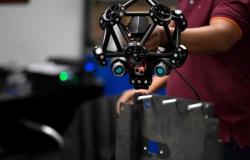A study from Laval University and the CHU de Québec-Université Laval Research Center proposes a new method for predicting the risk of preeclampsia which makes it possible to detect 77% of cases of severe preeclampsia.
This approach halves deliveries before the 34th week of pregnancy.
Preeclampsia
Preeclampsia is caused by poor implantation of the placenta in the uterus, making it harder for blood to reach the baby.
To compensate, the mother’s blood pressure increases, which can affect the functioning of her kidneys, liver and brain.
“The problem is generally diagnosed after the 20th week of pregnancy,” explains, in a press release, Emmanuel Bujold, clinical doctor teaching at the Faculty of Medicine who led the international research team. When preeclampsia becomes severe, doctors have no choice but to proceed with delivery, even if the development of the fetus is not complete.
Current method
Aspirin can prevent the majority of severe cases of preeclampsia, but because of the antiplatelet properties of this medication, doctors cannot prescribe it to all pregnant women.
“Taking daily aspirin from the 11th or 12th week of pregnancy prevents up to 90% of cases of preeclampsia which lead to deliveries before the 34th week of pregnancy,” emphasizes Professor Bujold, also a researcher at the Research Center. from the CHU de Québec-Université Laval, in the same communication to the media. The challenge is to identify early on which pregnant women need to take aspirin.”
The method currently used in Canada and the United States to identify women at risk of preeclampsia is based on variables such as the mother’s age and weight, whether it is a first pregnancy, We are in the presence of a multiple pregnancy, whether the mother has high blood pressure or whether the pregnancy results from in vitro fertilization.
“With this approach, we give aspirin to more than one in three women, but we detect barely half of the women who will suffer from preeclampsia,” underlines the researcher.
New approach
Hoping to do better, his team tested a new approach developed in the United Kingdom.
“It combines medical information about the mother as well as two indirect indices of the quality of implantation of the placenta in the uterus,” continues Emmanuel Bujold. The first, obtained by ultrasound, is a measurement of the pulsatility of the uterine artery, and the second is an assay of the blood levels of two proteins associated with pregnancy.
To compare the effectiveness of the two predictive tools, the researchers followed 7,325 women recruited when they were between the 11th and 14th week of a first pregnancy, during the project PREDICTION.
Of these, 65 suffered from preeclampsia before the 37th week of pregnancy, including 22 severe cases which required delivery before the 34th week of pregnancy.
“The current method would have made it possible to detect 59% of cases of severe preeclampsia and it would have generated 34% of false positives (women who were unnecessarily prescribed aspirin), indicates the professor. The new approach makes it possible to detect 77% of cases of severe preeclampsia and the false positive rate is 16%.
Testing
This new approach was tested at the Quebec City University Hospital with the help of more than 2,000 patients.
“It made it possible to reduce births before the 34th week of pregnancy by 50%,” underlines Professor Bujold. We now hope to be able to test it in a pilot project in Gaspésie. This approach not only ensures a safer pregnancy for the mother and child, but it does not generate additional expenses for the health system. The cost of caring for a single very premature baby can be very high. The savings generated by this new method of screening for preeclampsia would more than cover the costs of its implementation.” (CP/IJL)






